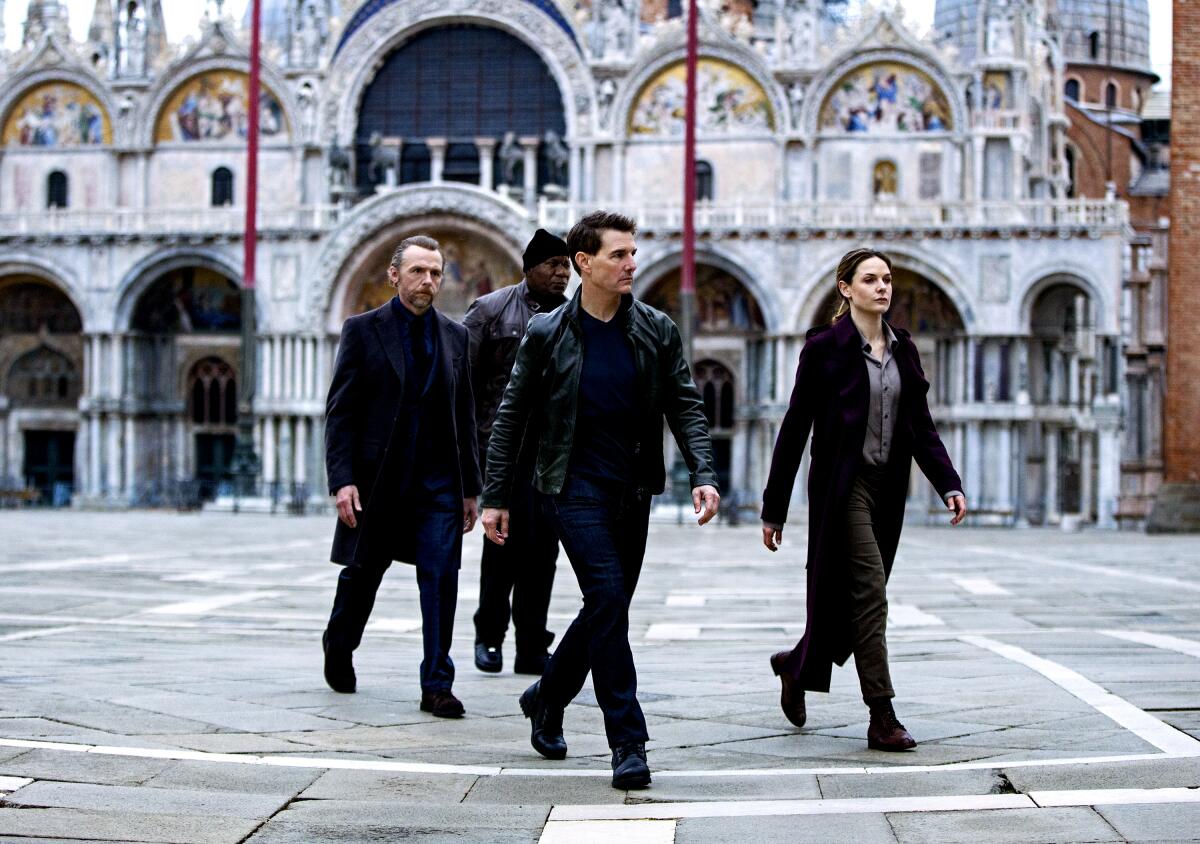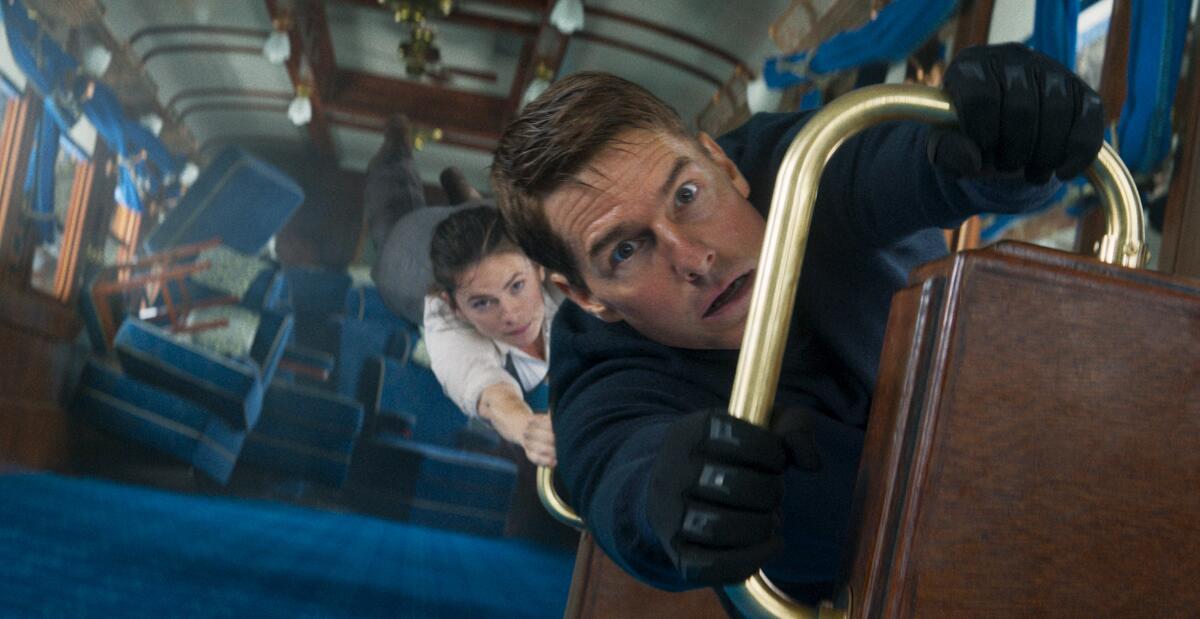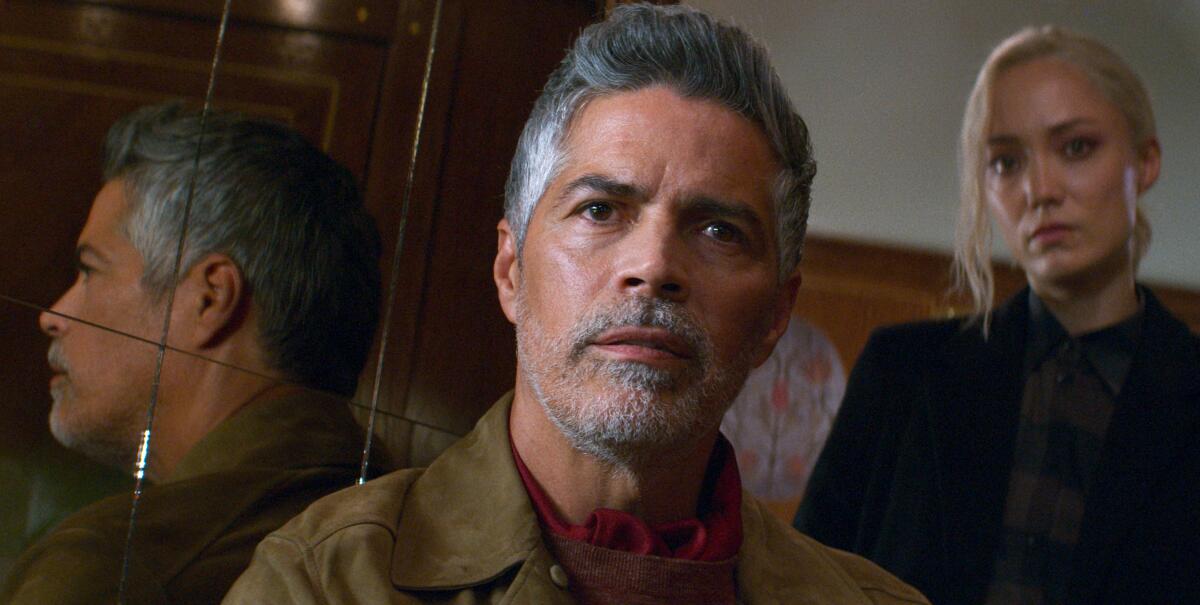Review: Tom Cruise is out to save the movies. Is ‘Mission: Impossible 7’ enough?

- Share via
It begins with a plunge into the icy deep, where a submarine is menaced by an invisible threat — a scene that induces shivery memories of “The Hunt for Red October” and “Das Boot” (and also triggers inevitable thoughts of a certain ill-fated submersible). Then it shifts to a hot orange desert, billed as Arabia though it might as well be Arrakis, where a dust-storm pursuit gives way to some tricky sleight-of-sand. Ludicrously entertaining and even more ludicrously titled, “Mission: Impossible — Dead Reckoning Part One” doesn’t just rack up the miles in style. Like so many globe-trotting thrillers and big-screen tourist brochures, it’s also a gleaming advertisement for Hollywood itself, a celebration and a reminder of how profoundly the movies have shaped our views of the world.
The task of saving that world once again falls to Ethan Hunt, a.k.a. Tom Cruise — and if the world can’t be saved, well, maybe at least the movies can. Or can they? Even if not, just try and stop Cruise, now 61, from taking the weight of the entire industry on his shoulders. His gargantuan cine-savior complex was apparent back in 2020, when he railed against COVID protocol violators on the U.K. set of “Dead Reckoning Part One,” captured in an audio recording that did not exactly self-destruct in five seconds. If the rant was overblown, this actor-producer is hardly alone in having bought into his own mythos: Earlier this year, Cruise was praised by none other than Steven Spielberg for having single-handedly “saved Hollywood’s ass” with the stunning success of “Top Gun: Maverick.”
Now, on the eve of this seventh “M:I” caper’s release, Cruise is playing the familiar role of the exhibitors’ evangelist, urging audiences on social media to seek out some of the summer’s biggest titles (“Indiana Jones and the Dial of Destiny,” “Barbie” and “Oppenheimer”) in theaters. The cross-studio solidarity is touching; it also reflects some of the industry’s deep existential anxieties around moviemaking and moviegoing. No single picture, no matter how successful, is going to lay those anxieties to rest, though “Dead Reckoning Part One,” with its queasily apocalyptic stakes and enjoyably kinked-up plot, at least seems to be in conversation with some of the underlying issues. Is it a coincidence that this time around, the movie’s big bad villain is artificial intelligence?

That would be something called the “Entity” — no, not the horror-movie incubus that menaced Barbara Hershey back in 1982, but rather a frighteningly self-aware robo-weapon powerful enough to bring data systems, economies and entire nations to their knees. Ethan and his loyal Impossible Mission Force gizmo experts, Luther (Ving Rhames) and Benji (Simon Pegg), are tasked with neutralizing this threat before it falls into the hands of the wrong country — which, as the movie cynically asserts, pretty much means any country. Fortunately, the Entity hasn’t reached Skynet levels of techno-malevolence yet; presumably that’s still to come in “Mission: Impossible — Dead Reckoning Part Two,” due out in theaters next year. For now, AI proves a frustratingly elusive phantom, one that acts primarily through a powerful human emissary, more devilish than angelic, named Gabriel (Esai Morales).
Flashbacks shed light on Gabriel and Ethan’s ugly, not always compelling history, which involves a confrontation, a betrayal and, surprise surprise, a beautiful dead woman. She’s a throwback to the many beautiful dead women from Ethan’s past, including three of his doomed IMF colleagues (played by Kristin Scott Thomas, Ingeborga Dapkūnaitė and Emmanuelle Béart) from the Brian De Palma-directed first “Mission: Impossible” feature (1996). Christopher McQuarrie, who directed the series’ two previous movies (“Rogue Nation” and “Fallout”) as well as both halves of “Dead Reckoning,” has a more restrained, less operatic visual style than De Palma (which could be said of most filmmakers). But in many respects he’s paying tribute to that 1996 caper, not only by staging a doozy of a runaway-train sequence, but also by reintroducing Ethan’s old IMF nemesis Eugene Kittridge, played once again by a banally sinister Henry Czerny.
Kittridge’s return can’t help but serve as a marker of how far Ethan, Cruise himself and this ever-durable series have come over nearly 30 years. It also suggests that the IMF, the utterly vital, eternally disavowable, brutally underloved bastard child of American intelligence, may not survive this latest and severest test of its abilities and resources. The “Dead” in the movie’s title certainly doesn’t bode well for anyone on-screen; neither does Ethan’s unnerving habit of reminding his closest colleagues that their survival means more to him than his own life. The sentiment may be cheesy, to the point where you half expect Ethan to pull off his latex mask and reveal Vin Diesel underneath. But it also reminds you that the “Mission: Impossible” movie franchise began with Ethan being framed for his teammates’ coolly premeditated murders, a formative trauma that he has never fully shaken off.

For the record:
10:50 a.m. July 5, 2023An earlier version of this review said Tom Cruise’s character maneuvered a yellow Beetle through the streets of Rome in one scene. It was a yellow Fiat.
It’s enough to make you fear for Ethan’s closest allies, among them Luther, Benji and the always-on-the-run Ilsa Faust (Rebecca Ferguson), all of whom are put in varying degrees of escalating danger as the typically serpentine narrative leaps from one spectacular piece of on-location fight choreography to the next. Notably, Ethan also finds himself a new sparring partner named Grace (a terrific Hayley Atwell), a wily thief who first pops up during an undercover operation at the Abu Dhabi airport before taking Ethan on a harrowing, sometimes hilarious ride (by yellow Fiat) through the streets of Rome. That Italian escapade soon leads to another in spooky nighttime Venice, where, in tight alleys and on haunted canals, the combat takes on a murderous close-quarters intimacy.
The quality of the action here is, for the most part, more fluid and satisfying than jaw-dropping; there’s nothing here to rival De Palma’s snazziest set pieces, or Ethan’s vertiginous climb up the walls of the Burj Khalifa in “Mission: Impossible — Ghost Protocol” (2011), or his men’s room demolition derby in 2018’s “Fallout.” But McQuarrie’s typically fastidious writing (undertaken this time with Erik Jendresen) makes up for whatever his direction may lack in sheer verve. And he does pull off one major cinematic coup: a triumphantly visceral, spatially disorienting, pull-out-the-stops ripsnorter of a climax that seems designed to ensure that no one dares set a movie aboard the Orient Express ever again, for fear of inviting unfavorable comparisons.
There’s more to the story, of course, which, though relatively fleeting at 163 minutes, feels generously overstuffed for a first-parter. I haven’t yet mentioned Pom Klementieff’s role as Paris, a lethally lithe newcomer of mysterious motives, killer threads and very few words. Or Vanessa Kirby, who, reprising her “Fallout” role as a ruthless arms dealer, has only to sit in a train car with a smartphone to deliver the movie’s single most impressive performance.
Maybe that’s unfair to Cruise, who once again suffers for our pleasure like no one else, hurling himself and his motorcycle from great heights, fighting in claustrophobically tight spaces and, yes, running and running and running some more. For all that, he knows how to temper his usual superhuman self-seriousness with lightness and wit. He’s even gracious enough to cede some of the spotlight to his co-stars this time around, spending a fair chunk of the movie’s endgame amusingly on the sidelines. He returns for the big-bang finish, of course, in a spirit of goofy optimism and eternal vigilance. “Dead Reckoning Part One” ends on his watch, but the movies will not.
——————
‘Mission: Impossible — Dead Reckoning Part One’
Rating: PG-13, for intense sequences of violence and action, some language and suggestive material
Running time: 2 hours, 43 minutes
Playing: Starts July 12 in general release
More to Read
Only good movies
Get the Indie Focus newsletter, Mark Olsen's weekly guide to the world of cinema.
You may occasionally receive promotional content from the Los Angeles Times.









